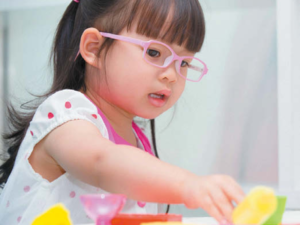The purpose of vision is TO GUIDE MOVEMENT!
But did you know that most infants “look” with their mouths… and then “look” with their hands before they trust their eyes??
The purpose of vision is to guide movement. During development, children gain more confidence in visual information as a substitute for the information that they once gathered through their mouth and hands.
For example, a curious infant will immediately bring an object to his mouth to assess its size and shape. A toddler will say, “I want to see it!” and promptly grab an object to explore it with her hands. With experience, however, children naturally depend more on visual input for information, and less on motor and tactile input (a development referred to as the visual-motor hierarchy).
Children who fidget excessively, have a hard time sustaining visual attention, have trouble with transitions, or tilt or turn their head during play might need guidance to support proper visual-motor development, which is critical to classroom learning.
The building blocks for visual-motor development are already in place at birth. These are the primitive reflexes, automatic movement patterns that position children to engage in new learning and a visually guided exploration of their world: righting the head, learning to crawl, moving the limbs independently and setting their sights on a destination.
From these early movements, children typically progress through several stages of visual-motor development. They learn to keep their eyes level, for better eye-teaming and binocular skills. They learn to follow moving targets with their eyes, and to respond to changes in motion with rapid eye jumps. They learn to estimate distances and the time it takes to travel them.
Gradually, there should be greater integration of visual and motor skills, from simple actions (moving an object from hand to hand) to fine-tuned ones (handwriting).
When children miss certain stages of visual-motor development, they can have difficulty in a classroom setting, which emphasizes visually based learning.
Some behavioral optometrists offer specific assessment of the primitive reflexes, which are critical in visual-motor development. These specialists can help children of any age, and even adults, revisit those missed learning stages with home-based exercises that will enable them to gather and process information more efficiently.
Samantha Slotnick, OD, has offices at 495 Central Park Ave, Ste. 301, Scarsdale, NY. For more information about primitive reflex assessment to help with learning, visit DrSlotnick.com/primitive, or call 914.874.1177 to attend a free workshop.



Leave a Reply